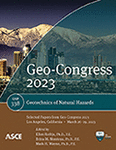Comparison of Equivalent Linear Site Response Analysis of Loose Gravelly Soil with Centrifuge Modeling Tests
Publication: Geo-Congress 2023
ABSTRACT
The purpose of this study is to compare results of site response analysis with the centrifuge model response of gravelly soils. A series of centrifuge modeling tests were performed at 50-g centrifuge gravitational acceleration to simulate a uniform soil profile subjected to a 1-Hz sinusoidal shaking motion with peak amplitudes ranging from 0.01 to 0.10 g. The soil tested in this study is a gravel-sand mixture of 50% gravel and 50% sand by weight, prepared in a loose condition. Dynamic soil properties of the material were assessed based on several methods, including resonant column, centrifuge bender element, and dynamic response of centrifuge model tests. Equivalent linear site response analysis was performed using DEEPSOIL to analyze the response of the same soil column as the prototype soil modeled in the centrifuge. An overall comparison of results shows that the equivalent linear site response analysis does not provide a good agreement of shear stress and shear strain for the loose gravelly soil observed in the centrifuge tests. At the shaking amplitude of 0.05 and 0.1 g, the shear strain appears to be comparable, but the equivalent linear method underestimated the shear stress. For the shaking amplitude of 0.01 g, the equivalent linear method overestimates surface response acceleration at frequencies higher than 2 Hz due to the variation of shear modulus reduction curve. For the shaking amplitude of 0.05 and 0.10 g, the equivalent linear method underestimates the surface response acceleration because the shear modulus decreases as the number of cycles increases.
Get full access to this article
View all available purchase options and get full access to this chapter.
REFERENCES
Afacan, K. B., Brandenberg, S. J., and Stewart, J. P. (2014). “Centrifuge modeling studies of site response in soft clay over wide strain range.” Journal of Geotechnical and Geoenvironmental Engineering, 140(2), 04013003.
Andrus, R. D., Zhang, J., Ellis, B. S., and Juang, C. H. (2003). “Guide for estimating the dynamic properties of South Carolina soils for ground response analysis.”, South Carolina Department of Transportation, Columbia, South Carolina.
Baturay, M. B., and Stewart, J. P. (2003). “Uncertainty and bias in ground-motion estimates from ground response analyses.” Bulletin of the Seismological Society of America, 93(5), 2025–2042.
Elgamal, A., Yang, Z., Lai, T., Kutter, B. L., and Wilson, D. W. (2005). “Dynamic response of saturated dense sand in laminated centrifuge container.” Journal of Geotechnical and Geoenvironmental Engineering, 131(5), 598–609.
Hashash, Y. M., Dashti, S., Romero, M. I., Ghayoomi, M., and Musgrove, M. (2015). “Evaluation of 1-D seismic site response modeling of sand using centrifuge experiments.” Soil Dynamics and Earthquake Engineering, 78, 19–31.
Kaklamanos, J., and Bradley, B. A. (2018). “Challenges in Predicting Seismic Site Response with 1D Analyses: Conclusions from 114 KiK‐net Vertical Seismometer ArraysChallenges in Predicting Seismic Site Response with 1D Analyses.” Bulletin of the Seismological Society of America, 108(5A), 2816–2838.
Kaklamanos, J., Bradley, B. A., Thompson, E. M., and Baise, L. G. (2013). “Critical parameters affecting bias and variability in site‐response analyses using KiK‐net downhole array data.” Bulletin of the Seismological Society of America, 103(3), 1733–1749.
Kaklamanos, J., Baise, L. G., Thompson, E. M., and Dorfmann, L. (2015). “Comparison of 1D linear, equivalent-linear, and nonlinear site response models at six KiK-net validation sites.” Soil Dynamics and Earthquake Engineering, 69, 207–219.
Kim, B., and Hashash, Y. M. (2013). “Site response analysis using downhole array recordings during the March 2011 Tohoku-Oki earthquake and the effect of long-duration ground motions.” Earthquake spectra, 29(1), 37–54.
Rayhani, M. H. T., and El Naggar, M. H. (2008). “Dynamic properties of soft clay and loose sand from seismic centrifuge tests.” Geotechnical and Geological Engineering, 26(5), 593–602.
Rollins, K. M., Evans, M. D., Diehl, N. B., and Daily, W. D., III. (1998). “Shear modulus and damping relationships for gravels.” Journal of Geotechnical and Geoenvironmental Engineering, 124(5), 396–405.
Zalachoris, G., and Rathje, E. M. (2015). “Evaluation of one-dimensional site response techniques using borehole arrays. Journal of Geotechnical and Geoenvironmental Engineering, 141(12), 04015053.
Zeghal, M., Elgamal, A. W., Zeng, X., and Arulmoli, K. (1999). “Mechanism of liquefaction response in sand-silt dynamic centrifuge tests.” Soil Dynamics and Earthquake Engineering, 18(1), 71–85.
Zhang, J., Andrus, R. D., and Juang, C. H. (2005). “Normalized shear modulus and material damping ratio relationships.” Journal of geotechnical and geoenvironmental engineering, 131(4), 453–464.
Information & Authors
Information
Published In
History
Published online: Mar 23, 2023
ASCE Technical Topics:
- Centrifuge models
- Engineering fundamentals
- Geomechanics
- Geotechnical engineering
- Geotechnical investigation
- Linear analysis
- Material mechanics
- Material properties
- Materials engineering
- Mechanical properties
- Models (by type)
- Shear modulus
- Shear stress
- Site investigation
- Soil analysis
- Soil dynamics
- Soil mechanics
- Soil properties
- Soil tests
- Stress (by type)
- Structural analysis
- Structural engineering
- Tests (by type)
Authors
Metrics & Citations
Metrics
Citations
Download citation
If you have the appropriate software installed, you can download article citation data to the citation manager of your choice. Simply select your manager software from the list below and click Download.
